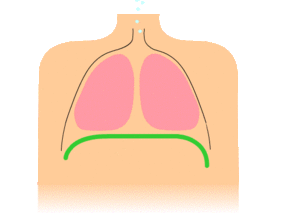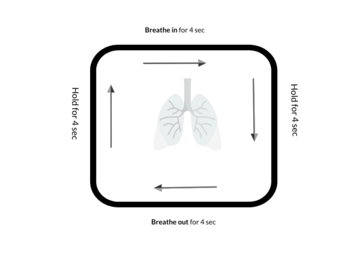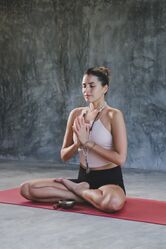Breathing Exercises: Difference between revisions
No edit summary |
No edit summary |
||
| (32 intermediate revisions by 6 users not shown) | |||
| Line 2: | Line 2: | ||
'''Original Editor '''- [[User:Lucinda hampton|Lucinda hampton]] | '''Original Editor '''- [[User:Lucinda hampton|Lucinda hampton]] | ||
'''Top Contributors''' - {{Special:Contributors/{{FULLPAGENAME}}}} | '''Top Contributors''' - {{Special:Contributors/{{FULLPAGENAME}}}} | ||
</div> | </div> | ||
== Introduction == | == Introduction == | ||
[[File: | [[File:Breathe.jpg|thumb| <small>''Breathing through the nose''</small>|297x297px]] | ||
Breathing exercises are a form of exercise | Breathing is an function controlled by the autonomic nervous system and is also under volotional control. Breathing exercises are a form of exercise which can improve the overall efficiency at which the lungs function. They can be helpful in individual with both healthy lungs as well as those with impaired lung function. In the absence of disease our breathing becomes altered with stress and when left unchecked over time can result in disordered breathing patterns. ([https://www.physio-pedia.com/Breathing_Pattern_Disorders breathing pattern disorder]) Disordered breathing can upset the [[oxygen]] and carbon dioxide exchange and contribute to anxiety, [[Panic Disorder|panic attacks]], fatigue, and other physical and emotional disturbances.<ref>Vidotto LS, Carvalho CRF, Harvey A, Jones M. Dysfunctional breathing: what do we know?. ''J Bras Pneumol''. 2019;45(1):e20170347. Published 2019 Feb 11. doi:10.1590/1806-3713/e20170347</ref> | ||
'''Benefits of breathing exercises include a variety of health-related reasons. eg: to enhance the [[Respiratory System|respiratory system]] by improving ventilation; [[Strength Training|strengthening]] [[Muscles of Respiration|respiratory muscles]]; make breathing more efficient; and for relieving stress and anxiety.'''<ref name=":0">Loren Toussaint, Quang Anh Nguyen, Claire Roettger, Kiara Dixon, Martin Offenbächer, Niko Kohls, Jameson Hirsch, Fuschia Sirois, "Effectiveness of Progressive Muscle Relaxation, Deep Breathing, and Guided Imagery in Promoting Psychological and Physiological States of Relaxation", ''Evidence-Based Complementary and Alternative Medicine'', vol. 2021, Article ID 5924040, 8 pages, 2021. <nowiki>https://doi.org/10.1155/2021/5924040</nowiki></ref> | |||
== Diaphragmatic Breathing == | |||
[[File:Diaphragmatic breathing.gif|thumb| ''<small>Diaphragmatic breathing</small>''|alt=|300x300px]] | |||
[[Diaphragmatic Breathing Exercises|Diaphragmatic breathing]] is a type of breathing exercise that helps strengthen the [[Muscles of Respiration|diaphragm]], the main muscle that helps with breathing, as it represents 80% of breathing. Diaphragmatic exercises help to make people feel relaxed and rested.<ref name=":0" /> | |||
This breathing exercise is also sometimes called <u>belly breathing</u> or <u>abdominal breathing.</u> | |||
Technique: | |||
== | * Position patient in a gravity-assisted position eg. semi fowler's positions | ||
* Focusing on the Diaphragm - Place one hand on the chest and the other on your stomach. Take a slow deep breath, paying attention to which hand moves. ''In diaphragmatic breathing, the stomach hand should move most'' | |||
* Slow the breathing - Inhale to fully inflate the lungs, then slowly exhale. Breathing out through the nose can help control exhalation rate. Pause briefly after exhaling then inhale again. | |||
== Pursed Lip Breathing == | |||
[[Pursed Lip Breathing|Pursed-lip breathing]] is a breathing technique that consists of exhaling through tightly pressed (pursed) lips and inhaling through the nose with the mouth closed. It is an effective way of slowing down breathing and increasing exhalation time allowing more air to be released with each breath cycle. | |||
This technique has been found to benefit people who have obstructive lung diseases eg [[Chronic Obstructive Pulmonary Disease Rehabilitation Class|chronic obstructive pulmonary disease]] (COPD)<ref name=":1">Lu Y, Li P, Li N, et al. Effects of Home-Based Breathing Exercises in Subjects With COPD. ''Respir Care''. 2020;65(3):377-387. doi:10.4187/respcare.07121</ref> and asthma leading to dyspnea during exertion. | |||
=== Deep Breathing === | |||
Deep breathing helps to reexpand lungs and can be useful for improving ventilation esp following surgery where certain areas of the lungs may be underventilated due to pain. It can also be called lateral costal or umbrella breathing and can be done unilaterally or bilaterally. Deep breaths are also necessary for sputum mobilisation and form part ot the Active Cycle of Breathing Techniques mentioned below. | |||
Technique: | |||
* While standing or sitting, place your hands on the lower aspect of the rib cage. | |||
* Instruct patient to breathe out and apply pressure in downward and inward direction. | |||
* Shortly before instructing the patient to breathe in, apply quick stretch in the down and inward direction | |||
* With the tactile stimulation and cuing, facilitate patient to take a deep breath in | |||
* Slowly release your breath by exhaling through the nose | |||
== Active Cycle of Breathing Techniques == | |||
The [[Active Cycle of Breathing Technique|Active Cycle of Breathing Techniques]] (ACBT) is an active breathing technique performed by the patient and can be used to mobilize and clear excess pulmonary secretions and to generally improve lung function. Once ACBT has been taught, the patient can be encouraged to use it independently without the supervision of a physiotherapist. This exercise does not require the use of any special equipment. | |||
=== Box Breathing === | |||
Box breathing can be helpful with relaxation. Box breathing is a breathing exercise to assist patients with stress management and can be implemented before, during, and/or after stressful experiences. Box breathing involves visualizing a journey around the four sides of a square, pausing while traveling horizontally, and breathing in while traveling up the square and out while traveling down it. This exercise can be implemented in many environments, not requiring a calm environment to be effective. | |||
[[File:Box Breathing.png|center|frameless|350x350px]] | |||
* Step One: Breath in through the nose for a count of 4. | |||
* Step Two: Hold your breath for a count of 4. | |||
* Step Three: Breath out for a count of 4. | |||
* Step Four: Hold your breath for a count of 4. | |||
* Repeat<ref>Norelli SK, Long A, Krepps JM. Relaxation Techniques. [Updated 2023 Aug 28]. In: StatPearls [Internet]. Treasure Island (FL): StatPearls Publishing; 2023 Jan-. Available from: <nowiki>https://www.ncbi.nlm.nih.gov/books/NBK513238/</nowiki></ref> | |||
=='''Research Findings'''== | |||
[[File:Chill.jpeg|thumb|250x250px| <small>Relaxed breathing</small>]] | |||
Breathing affects all body systems; these systems in turn influence breathing. Optimal breathing patterns help to maintain homeostasis, but when breathing is disrupted, significant issues can arise. | |||
Examples of how breathing can help in health outcomes are shown below: | |||
= | * Breathing exercises can improve pulmonary function, respiratory muscle strength, exercise capacity, [[Dyspnoea|dyspnea]], and health-related quality of life in patients with COPD<ref name=":1" /> | ||
* | * Evidence suggests that diaphragmatic breathing may decrease stress as measured by physiologic biomarkers, as well psychological self-report tools <ref>Hopper SI, Murray SL, Ferrara LR, Singleton JK. Effectiveness of diaphragmatic breathing for reducing physiological and psychological stress in adults: a quantitative systematic review. ''JBI Database System Rev Implement Rep''. 2019;17(9):1855-1876. doi:10.11124/JBISRIR-2017-003848</ref> | ||
*x | * Evidence exists to support the use of breathing exercises in the treatment of chronic, nonspecific [[Low Back Pain|low back pain]].<ref>Anderson BE, Bliven KCH. The Use of Breathing Exercises in the Treatment of Chronic, Nonspecific Low Back Pain. ''J Sport Rehabil''. 2017;26(5):452-458. doi:10.1123/jsr.2015-0199</ref> | ||
* The way of breathing decisively influences autonomic and [[Pain Mechanisms|pain]] processing. Deep slow breathing in concert with [[Relaxation Techniques|relaxation]] are essential feature in the modulation of [[Vagus Nerve|sympathetic]] arousal and pain perception. Thus can be useful in [[Chronic Pain and the Brain|chronic pain]] management.<ref>Busch V, Magerl W, Kern U, Haas J, Hajak G, Eichhammer P. The effect of deep and slow breathing on pain perception, autonomic activity, and mood processing--an experimental study. ''Pain Med''. 2012;13(2):215-228. doi:10.1111/j.1526-4637.2011.01243.x</ref> | |||
* Breathing exercises for adults with asthma may have some positive effects on [[Quality of Life|quality of life]], [[Breathing Pattern Disorders|hyperventilation]] symptoms, and [[Pulmonary Function Test|lung function]]<ref>Santino TA, Chaves GS, Freitas DA, Fregonezi GA, Mendonça KM. Breathing exercises for adults with asthma. ''Cochrane Database Syst Rev''. 2020;3(3):CD001277. Published 2020 Mar 25. doi:10.1002/14651858.CD001277.pub4</ref> | |||
See [[The Science of Breathing Well]] | |||
== References == | == References == | ||
<references /> | |||
<references /> | [[Category:Respiratory Disease - Interventions]] | ||
[[Category:Respiratory]] | |||
[[Category:Health and Well-being]] | |||
Revision as of 05:03, 22 November 2023
Original Editor - Lucinda hampton
Top Contributors - Lucinda hampton, Prashna Singh, Stella Constantinides, Robin Amel, Kim Jackson, Samuel Winter and Rishika Babburu
Introduction[edit | edit source]
Breathing is an function controlled by the autonomic nervous system and is also under volotional control. Breathing exercises are a form of exercise which can improve the overall efficiency at which the lungs function. They can be helpful in individual with both healthy lungs as well as those with impaired lung function. In the absence of disease our breathing becomes altered with stress and when left unchecked over time can result in disordered breathing patterns. (breathing pattern disorder) Disordered breathing can upset the oxygen and carbon dioxide exchange and contribute to anxiety, panic attacks, fatigue, and other physical and emotional disturbances.[1]
Benefits of breathing exercises include a variety of health-related reasons. eg: to enhance the respiratory system by improving ventilation; strengthening respiratory muscles; make breathing more efficient; and for relieving stress and anxiety.[2]
Diaphragmatic Breathing[edit | edit source]
Diaphragmatic breathing is a type of breathing exercise that helps strengthen the diaphragm, the main muscle that helps with breathing, as it represents 80% of breathing. Diaphragmatic exercises help to make people feel relaxed and rested.[2]
This breathing exercise is also sometimes called belly breathing or abdominal breathing.
Technique:
- Position patient in a gravity-assisted position eg. semi fowler's positions
- Focusing on the Diaphragm - Place one hand on the chest and the other on your stomach. Take a slow deep breath, paying attention to which hand moves. In diaphragmatic breathing, the stomach hand should move most
- Slow the breathing - Inhale to fully inflate the lungs, then slowly exhale. Breathing out through the nose can help control exhalation rate. Pause briefly after exhaling then inhale again.
Pursed Lip Breathing[edit | edit source]
Pursed-lip breathing is a breathing technique that consists of exhaling through tightly pressed (pursed) lips and inhaling through the nose with the mouth closed. It is an effective way of slowing down breathing and increasing exhalation time allowing more air to be released with each breath cycle.
This technique has been found to benefit people who have obstructive lung diseases eg chronic obstructive pulmonary disease (COPD)[3] and asthma leading to dyspnea during exertion.
Deep Breathing[edit | edit source]
Deep breathing helps to reexpand lungs and can be useful for improving ventilation esp following surgery where certain areas of the lungs may be underventilated due to pain. It can also be called lateral costal or umbrella breathing and can be done unilaterally or bilaterally. Deep breaths are also necessary for sputum mobilisation and form part ot the Active Cycle of Breathing Techniques mentioned below.
Technique:
- While standing or sitting, place your hands on the lower aspect of the rib cage.
- Instruct patient to breathe out and apply pressure in downward and inward direction.
- Shortly before instructing the patient to breathe in, apply quick stretch in the down and inward direction
- With the tactile stimulation and cuing, facilitate patient to take a deep breath in
- Slowly release your breath by exhaling through the nose
Active Cycle of Breathing Techniques[edit | edit source]
The Active Cycle of Breathing Techniques (ACBT) is an active breathing technique performed by the patient and can be used to mobilize and clear excess pulmonary secretions and to generally improve lung function. Once ACBT has been taught, the patient can be encouraged to use it independently without the supervision of a physiotherapist. This exercise does not require the use of any special equipment.
Box Breathing[edit | edit source]
Box breathing can be helpful with relaxation. Box breathing is a breathing exercise to assist patients with stress management and can be implemented before, during, and/or after stressful experiences. Box breathing involves visualizing a journey around the four sides of a square, pausing while traveling horizontally, and breathing in while traveling up the square and out while traveling down it. This exercise can be implemented in many environments, not requiring a calm environment to be effective.
- Step One: Breath in through the nose for a count of 4.
- Step Two: Hold your breath for a count of 4.
- Step Three: Breath out for a count of 4.
- Step Four: Hold your breath for a count of 4.
- Repeat[4]
Research Findings[edit | edit source]
Breathing affects all body systems; these systems in turn influence breathing. Optimal breathing patterns help to maintain homeostasis, but when breathing is disrupted, significant issues can arise.
Examples of how breathing can help in health outcomes are shown below:
- Breathing exercises can improve pulmonary function, respiratory muscle strength, exercise capacity, dyspnea, and health-related quality of life in patients with COPD[3]
- Evidence suggests that diaphragmatic breathing may decrease stress as measured by physiologic biomarkers, as well psychological self-report tools [5]
- Evidence exists to support the use of breathing exercises in the treatment of chronic, nonspecific low back pain.[6]
- The way of breathing decisively influences autonomic and pain processing. Deep slow breathing in concert with relaxation are essential feature in the modulation of sympathetic arousal and pain perception. Thus can be useful in chronic pain management.[7]
- Breathing exercises for adults with asthma may have some positive effects on quality of life, hyperventilation symptoms, and lung function[8]
See The Science of Breathing Well
References[edit | edit source]
- ↑ Vidotto LS, Carvalho CRF, Harvey A, Jones M. Dysfunctional breathing: what do we know?. J Bras Pneumol. 2019;45(1):e20170347. Published 2019 Feb 11. doi:10.1590/1806-3713/e20170347
- ↑ 2.0 2.1 Loren Toussaint, Quang Anh Nguyen, Claire Roettger, Kiara Dixon, Martin Offenbächer, Niko Kohls, Jameson Hirsch, Fuschia Sirois, "Effectiveness of Progressive Muscle Relaxation, Deep Breathing, and Guided Imagery in Promoting Psychological and Physiological States of Relaxation", Evidence-Based Complementary and Alternative Medicine, vol. 2021, Article ID 5924040, 8 pages, 2021. https://doi.org/10.1155/2021/5924040
- ↑ 3.0 3.1 Lu Y, Li P, Li N, et al. Effects of Home-Based Breathing Exercises in Subjects With COPD. Respir Care. 2020;65(3):377-387. doi:10.4187/respcare.07121
- ↑ Norelli SK, Long A, Krepps JM. Relaxation Techniques. [Updated 2023 Aug 28]. In: StatPearls [Internet]. Treasure Island (FL): StatPearls Publishing; 2023 Jan-. Available from: https://www.ncbi.nlm.nih.gov/books/NBK513238/
- ↑ Hopper SI, Murray SL, Ferrara LR, Singleton JK. Effectiveness of diaphragmatic breathing for reducing physiological and psychological stress in adults: a quantitative systematic review. JBI Database System Rev Implement Rep. 2019;17(9):1855-1876. doi:10.11124/JBISRIR-2017-003848
- ↑ Anderson BE, Bliven KCH. The Use of Breathing Exercises in the Treatment of Chronic, Nonspecific Low Back Pain. J Sport Rehabil. 2017;26(5):452-458. doi:10.1123/jsr.2015-0199
- ↑ Busch V, Magerl W, Kern U, Haas J, Hajak G, Eichhammer P. The effect of deep and slow breathing on pain perception, autonomic activity, and mood processing--an experimental study. Pain Med. 2012;13(2):215-228. doi:10.1111/j.1526-4637.2011.01243.x
- ↑ Santino TA, Chaves GS, Freitas DA, Fregonezi GA, Mendonça KM. Breathing exercises for adults with asthma. Cochrane Database Syst Rev. 2020;3(3):CD001277. Published 2020 Mar 25. doi:10.1002/14651858.CD001277.pub4










